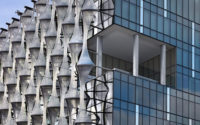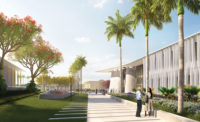Security Issues Central to Design Scheme
As part of its ongoing effort to fortify and modernize embassies worldwide, the U.S. State Department unveiled plans for its highest-profile project yet, awarding the New London Embassy to KieranTimberlake on February 23.
Click on the slide show icon to see additional photos.
With a concept that seeks to blend iconic design with the State Department’s demand for a highly secure and sustainable facility, the firm has earned equal parts praise from its client and derision from some critics.
At a cost of $1 billion, according to The Times of London, the 500,000-square-foot facility would be the most expensive embassy ever built. Ground breaking is scheduled for 2013 with completion in 2017. The embassy will be built on a nearly 5-acre site on the south bank of the Thames River.
Stephen Kieran, FAIA, says his firm saw the project as an opportunity to rethink the relationship between symbolic intent and security. The Philadelphia-based firm partnered heavily with consultants early in the process, including Sako & Associates for technical security. “Clearly this is a new architectural problem for all of us,” Kieran said. “In the past, security has been handled as an ‘add-on.’ We think we’ve balanced the two in a new way.”
While security features are mostly classified, the architect pointed to certain elements apparent on the exterior. For instance, rather than using fortress-like perimeter walls and fences, the embassy will be centered in a park. Spiraling walkways will create natural barriers, as will a large pond that some have dubbed “the moat.”
For the chancery building, the architects propose a transparent, crystalline cube atop a colonnade. The building will be skinned with an ethylene-tetrafluoroethylene (ETFE) scrim that helps reduce solar gain while also transforming it into energy via a thin film of photovoltaics in the ETFE foils. Moreover, the skin is blast-resistant.
Kieran notes that the concept exceeded State Department goals for sustainability and is designed to meet LEED Platinum standards, with the potential to achieve carbon neutrality. “The intent is that no one will ever be able to know where aesthetics ends and performance begins,” he says.
Although the design beat out concepts from Morphosis Architects, Pei Cobb Freed & Partners, and Richard Meier & Partners, it hasn’t won praise from some key critics. Nicolai Ouroussoff of The New York Times called it bland with “all the glamour of a corporate office block.” Bloomberg’s James S. Russell wrote that because of the heavy focus on sustainability and security, the design “does not coalesce into a persuasive statement about America.” And Jay Merrick of the U.K.’s The Independent acknowledged that the design likely has technical and operational merits but wasn’t the most intriguing of the finalists.
Kieran says he won’t be distracted by the controversy. “We have very positive views of the project, and we’re going to go forward with that in mind,” he said. “We understand and are aware of criticism, but it just comes with the turf.”
Clarification: The original story should have identified Stephen Kieran as an AIA Fellow.




Post a comment to this article
Report Abusive Comment